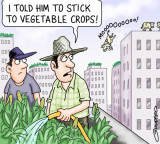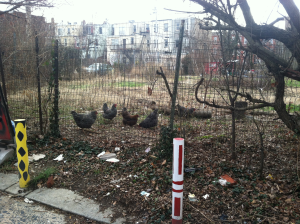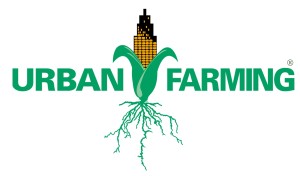A Definitely Good Approach to (Urban) Living…

On an city hike earlier today, we came upon this Station North urban farm where we spotted a bunch of hens (roosters are illegal), a coop, active bee hives and tilled land that surely had produced some agricultural products last growing season. Some of the hens gave us a visit, looking for something edible. (We weren’t prepared.) Incidentally, the number of hens on a Baltimore City farm are governed by the square footage of the site–max of 10 on any site which looked to be the case here.
Open space in cities used to be seen in parks and along broad roadway medians–with farms at the edge. Mostly, anyway. The suburbs have displaced farms at the urban edge, pushing them farther from city life experience over the last two generations. Bringing some level of farming back within the city limits helps us to re-connect with some of the basics of life not otherwise so often seen or experienced. Sounds trite, I guess. But, true, I think.
Several years ago the Baltimore Food Policy Initiative was introduced by the city’s Office of Sustainability. Some pretty important organizations are funding the Initiative: Kaiser Permanente; the Abell Foundation; the Annie E. Casey Foundation; and, the Baltimore Community Foundation.
Thankfully, one of the demands of the Office of Animal control if you want to farm in Charm City: An affidavit certifying that the applicant or agent of the applicant has never been convicted of animal abuse, cruelty or neglect. Want to know more of the requirements for urban farming in Baltimore?
 One creature that doesn’t require documentation is this noisy, busy one we heard/spotted.
One creature that doesn’t require documentation is this noisy, busy one we heard/spotted.
And, if you haven’t seen everything yet, check out this state-by-state “directory of chicken laws.” Seems a bit dated, but you gotta like the energy behind it.
I blogged about urban farming by Bronx, NY’s Discovery High School students and teacher Stephen Ritz here, if you missed it.

